5 Most Controversial Rare Coins from the US Mint
Posted on- Type 1 Standing Liberty Quarter
- 1909-S VDB Cent
- 1964-D Peace Dollar
- 1946 Roosevelt Dime
- $1,000,000,000,000 Platinum Coin
From illegal to immoral to outrageous, it turns out there’s plenty of ways for a U.S. rare coin to be controversial. Today, we explore five of the most controversial coins produced by the U.S. Mint, many of which are highly coveted by collectors in large part due to their controversy!
1. Type 1 Standing Liberty Quarter
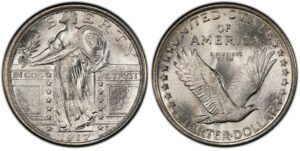
The classic Type 1 Standing Liberty Quarter was minted in 1916 and 1917 featuring one of the most elaborate designs on any U.S. coin. Sculptor Hermon MacNeil designed this coin depicted Lady Liberty standing between to pedestals wearing a flowing gown.
The controversy? Lady Liberty’s right breast was not covered. There was an immediate public outcry over public nudity when these coins were released into circulation! The Society for the Suppression of Vice began a campaign urging the U.S. government to halt production of the coin they called “immoral” and also asked for a recall for the coins already in circulation.
The U.S. mint produced and released into circulation 55,230,000 coins before production of the Type I design was halted. In 1917, without input from MacNeil, the Liberty Quarter was restruck with a covering over her upper torso that resembled chain mail—returning dignity to Lady Liberty.
The Type 1 Standing Liberty Quarter is an early classic, highly collectable and demands a large premium over the Type II Standing Liberty quarters.
2. 1909 VDB Cent
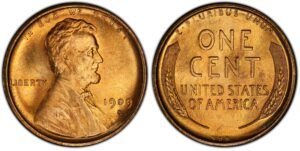
Throughout history only a few men rose to such prominence to be instantly recognized by their initials. There’s a few: like FDR, JFK and LBJ. However, within the numismatic world, expert collectors instantly recognize the initials VDB.
Who is VDB you may wonder? Born Viktoras Barnauskas on June 12, 1871 in Shavli, Lithuania, Brenner immigrated to America arriving in 1890. Eventually, Brenner became a New York City jewelry engraver. However, his true passion was medals, sculpting and numismatics.
In 1908, President Roosevelt wanted a new coin to honor the 100th anniversary of Abraham Lincoln’s birth. Roosevelt explored the idea of featuring an image of Lincoln on the coin as he considered and ultimately accepted the proposal submitted by Victor David Brenner.
The public eagerly anticipated the release of the new Lincoln cent in 1909 as this was the first ever regular issue coin in American history to feature a real person! On August 2, 1909, the police were called in to keep the crowds in order, as the coin was distributed for the first time at a Treasury building on Wall Street.
Within a few short days, controversy and scandal broke out over Brenner’s initials V.D.B on the reverse. Public outcry and complaints emerged over the size and placement of the initials.
As the controversy swirled, only a few days after production began, Treasury Secretary Franklin MacVeagh sent a message: Stop the mints! He halted production of the coin and ordered the initials removed. In that short time, however, almost 28 million cents were struck in Philadelphia and 484,000 at the San Francisco Mint.
The Lincoln cent was the only coin ever designed by Brenner, but his tribute lives on as one of the most popular and widely used coins in American history.
3. 1964-D Peace Dollar
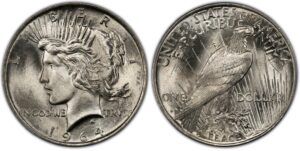
U.S. Mint records state that 316,076 silver Peace dollars were struck at the Denver Mint in May of 1965 (though they were backdated to 1964).
At the time, a massive silver shortage made these Peace dollars significantly more valuable for their silver content than their $1 face value. Indeed before these coins were even released to the public, private collectors were advertising offers of $7.50 each to buy the coins. Amid concerns of public hoarding, the silver Peace dollar program was cancelled and the coins were condemned to the melting pot. The 1964 Peace Dollars were never released to the public.
And, notably, today, it is illegal to possess a 1964-dated Peace dollar.
So do any still exist today? According the official story, at the time, all but two of the 1964 Peace Dollars were melted down for their silver content. The two survivors were reportedly sent to Washington, D.C., where they remained until 1970 when Mint records say they too were melted in the presence of a destruction committee.
Legend has it that there may be a survivors. There are rumors that every employee in the Denver Mint received two coins each, and it’s possible that Mint employees could have pocketed one without anyone looking. But even if a 1964 Peace Dollar were found today, it would be illegal to own since the coin was never officially monetized.
4. 1946 Roosevelt Dime
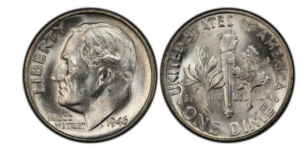
In 1946, the U.S. Treasury introduced the Roosevelt dime to honor the recently deceased president. At this point in history, the public mood of the nation was cautious. The Cold War was just beginning and Senator McCarthy had launched his anti-Communist movement.
On the dime’s design, below Roosevelt’s neck and to the left of the date a small JS is featured, the designer’s initials.
A conspiracy theory quickly spread across the nation like wildfire that accused U.S. Mint workers of being Communists, and the JS was a secret message to honor Soviet dictator Joseph Stalin. The Mint received a huge number of letters accusing them of promoting Communism with the release of the new dime. The rumors were so pervasive that the U.S. Mint had to issue a press release to dispel the controversy, but they kept the initials on the dime.
5. $1,000,000,000,000 Platinum Coin
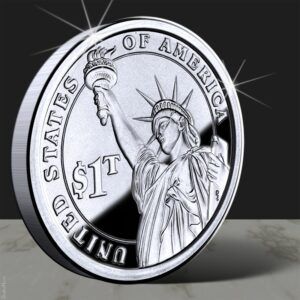
This last controversial coin has not yet been minted. It is a proposed trillion dollar platinum coin that has been bandied about at times as a solution to the various debt limit crisis that the U.S. government has faced. On numerous occasions in recent years, the U.S. government has come up against the deadline where it would run out of money to pay its bills. In 2001, Congress passed a law that allows the U.S. Treasury to mint platinum coins of any value without Congressional approval. According to that law, the U.S. Treasury could set the coin’s value at anything, they choose. But, the coin would need to be struck in platinum, not gold or silver, nickel, bronze or copper, which are under Congress’ control.
In theory, a U.S. President could order the Treasury Secretary mint a coin with the value of $1 trillion and then deposit it into the Treasury, giving the government an extra trillion dollars to cover debts and prevent default.
The proposal has resurfaced from time to time over the years as Congress has several times faced debt limit battles. However, the proposal has been called a “gimmick” and has been met with controversy over concerns it would debase “the full faith and credit” that is currently entrusted into our nation’s currency. But, could it be done? Technically it appears yes.
Want to read more? Subscribe to the Blanchard Newsletter and get our tales from the vault, our favorite stories from around the world and the latest tangible assets news delivered to your inbox weekly.







